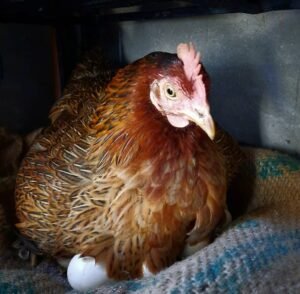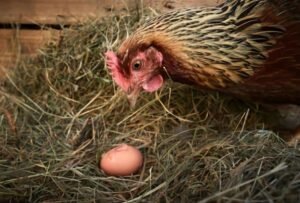Plymouth Rock Chicken – Characteristics, Origin, Breed Info and Lifespan

If you are interested in getting the Plymouth Rock chicken breed for your backyard poultry or for commercial purposes, then this guide will be of help to you.
In this guide, you will learn everything you need to know about Plymouth Rock chickens.
You will learn about their origin, characteristics, lifespan and other fun facts.
In addition, you get answers to most of the frequently asked questions about the Plymouth Rock chicken breed.
The aim of the information in this article is to help you make the decision whether this breed of chicken is the right one for you.
So, if this is what you are looking for, then continue reading till the end to get details about the Ply Mouth Rock chickens.
Let’s get started.
You may like to also read about these Top 13 Black and White Chicken Breeds (With Pictures).
What is a Plymouth Rock Chicken?
Before the end of historic World War II, the Plymouth hen was America’s main source of chicken eggs and meat.
Many call it the oldest American Chicken breed because its history dates back to the 19th century.
The Plymouth Rock Chicken is a dual-purpose chicken breed.
Which means that it can be reared for meat, eggs, or both. It has a yellow skin color and usually, the eggshell is brownish in color.
This American breed of domestic chicken is very resistant to cold, easy to manage, and a very good sitter.
Generally, the Plymouth chicken breed is a good farm chicken.
At the end of this article, you will get all the information you need to own and rear a Plymouth Rock Chicken breed.
Of course, we bring you details on the variety of this chicken breed and its egg-laying ability.
In addition to that, you will know how to care for them.
Let’s journey together, farmer!!!
What is the Origin And History of Plymouth Rock Chickens?
The origin of the Plymouth breed of chicken can be traced to the 19th century in America.
However, in 1869, it was first considered a breed of chicken.
History has it that its invention was a result of crosses of Dominique, Java, Cochin, and Brahma chickens.
Its first popular variety is the barred Plymouth Rock Chicken breed.
Before World War II, almost everyone used to keep them.
Even the then Government encouraged its keep.
Why?
Because the fighting troops needed enough food to do the fighting thing.
And basically, Plymouth Rock was a great deliverer.
That is because it is a dual-purpose chicken that is a source of meat and egg.
So, it satisfied the soldiers’ needs to an extent.
But sadly, after the war, the Plymouth Rock Chicken was cast aside.
And the chicken industry became highly mechanized.
This led to the introduction of varieties of Plymouth Rock Chicken aside from the barred Plymouth.
The barred Plymouth has outstanding characteristics that made it an attraction to be bred and kept as a farm chicken.
Basically, the only hen that could rival it was the Rhode Island Red.
Following the barred Plymouth breed are the White, Buff, Partridge, Silver Penciled, Blue, and the Columbian breed of Plymouth Rock Chicken.
Interestingly, these other varieties of the Plymouth Rock Chicken breed are from crosses containing some of the same ancestral backgrounds as the barred breed.
Before now, the name Plymouth Rock referred to just the barred bird.
However, with the breed varieties, it’s now a name for a breed of chicken.

What are the characteristics of Plymouth Rock chickens?
How would you spot a Plymouth Rock Chicken if you saw one?
Can you?
Well, just like most other chicken breeds, Plymouth Rock chickens have a defining factor.
Below are the defining characteristics of the Plymouth chicken;
1. Their Bodies are Broad and Long
Usually, they possess a broad long back, moderately deep, full breast
Also, their body is triangular-shaped.
2. Their Feathers are Short, Soft, and Hardly Tangle
Looking at a Plymouth Rock Chicken, their feathers are not so long but they are really full. Also, the feathers are fairly loosely held.
In other words, they hardly tangle. Which makes them very soft, especially in the abdominal region.
The Plymouth chicken breed is not quite aggressive. Therefore, they can be tamed easily.
And lastly, the Plymouth breed of chicken usually makes good mothers.
3. The Plymouth Rock Chicken has Colours Peculiar to its Variety.
The barred chicken breed of Plymouth is basically defined as black and white.
But the Dominique breed is kind of grey in color.
Usually, their eyes are reddish while their skin and legs are yellowish.
Their beak possesses the color of a horn.
Their ear lobes, comb, and wattles which mark the facial regions are red in color.
However, to differentiate between the sexes by color, here’s how to do that;
- For the male, the black and white barring is equal. But the females have dark tips at the end of each feather.
- Also, the females have black bars that are slightly wider than their white bars. This makes them a slightly darker greyish hue than the roosters.
4. The Legs of the Plymouth Rocks are Usually Clean
Plymouth Rocks have yellow legs which are often clean. Each door has four toes.
5. Plymouth Rocks Have Single Combs
Their comb is usually single with 5 points and moderate in size.
6. The Plymouth Chicken Breed Weighs Between 7½ and 9½ lbs.
A Plymouth Rock Chicken hen weighs about 7½lbs.
And the roosters weigh about 9½lbs.
7. The Plymouth Rock Chicken is Healthy Birds
Basically, the Plymouth Rocks are healthy and sturdy.
In cold weather, the roosters need attention on their wattles and large combs.
They are not disturbed by bird diseases and ailments. Except for the usual array of parasites.
8. Plymouth Rocks Live Really Long
For the length of days, they usually live long.
Most tend to live up to 10-12 years. Of course, if they’re properly cared for!!!
However, exceptional birds have lived up to 20 years!
9. Plymouth Rocks are Excellent Egg and Meat Producers
The Plymouth chicken is perfect for the production of both eggs and meat.
10. They are Broody, Hard, and Docile.
The Plymouth chicken is broody, hard, and docile simultaneously.
Some males and hens of this breed are big and active enough.
Table summarizing the Plymouth Rock chicken breed information
| Skin color | Yellow |
| Egg color | Brown |
| Comb type | Single |
| Setter/Broody | Yes |
| Especially Docile | Yes |
| Use | Dual-purpose breed |
| Cold Hardiness | Hardy in winter |
| Conservation status | Recovering |
| Heat Tolerance | Tolerates heat well |
| Also Known As | Rock or Barred Rock |
| Personality | Smart, plucky and docile |
| Country of origin | United States of America |
| Standard | Plymouth Rock Club of Australia |
| Bears Confinement | Bears confinement well |
| Weight | Male: Standard minimum weight: 3.4 kg (7.5 lb)Female: Standard minimum weight 2.95 kg (6.5 lb) |
| Varieties | Barred, Blue, Buff, Colombian, Partridge, Silver Penciled, and White. (All are rare except the barred and the white) |
Why Choose Plymouth Rock chickens?
Choosing this chicken breed to rear comes with a lot of advantages.
Here are the reasons why you should add the Plymouth Rock Breed to your backyard farm;
1. They’re Dual-purpose Chickens
You get to have eggs and meat from just one source.
2. They are Easy to Manage
Plymouth Rocks are really very easy to manage. That comes with low maintenance.
3. These Chicken Breeds are Resistant to Cold.
Also, they are resistant to cold. In other words, you wouldn’t have to worry much about lighting the pen house.
That will save costs as well.
4. Plymouth Rocks are Not Noisy
Also, they’re not going to disturb the neighborhood.
The Plymouth Rocks are not noisy birds. As long as they have food and water, they’re good to go.
5. The Plymouth Breed are Poor Flyers
What this means is that you wouldn’t worry about finding your bird in your neighbor’s backyard.
Why?
Because they can’t fly over the fence. Unless the fence is really low.

What are the Disadvantages Of Having the Plymouth Rock Chickens?
As much as this chicken has many accolades for its breed, it could be a strain on the breeders at some point.
Here are some of the reasons why this breed might not be the one for you;
- Plymouths are small in Size
The Plymouth chicken breed is really small in size.
This makes it quite difficult to differentiate when they are healthy or growing.
- They have Shallow Breasts
Also, they have really shallow breasts, narrow bodies, and high tails.
Classification of Plymouth Rock Chicken Breed
Today’s Barred Rock hens can be basically divided into three separate groups:
Exhibition Group: These birds are all about conformation and plumage. Often productivity will suffer.
Industrial Production Group: High-volume producers bred for the poultry industry. Often not suitable for 4H purposes.
Old Dual Purpose Group: These are the kind of hens that Grandma had. Dependable for eggs and meat. Long-lived and amiable, requiring minimal care.
Frequently Asked Questions About Plymouth Rock Chickens
What is the lifespan of Plymouth Rock Chickens?
As earlier stated, these birds can live really long.
They have a lifespan of about 10-12 years. Of course, if they’re properly cared for!!!
But however, some can stretch up to 20 years!!! Those we consider exceptional!!!
Are Plymouth Rock Chickens good for meat?
Having this species of chicken breed for meat depends on some factors.
However, some strains are good layers while others are bred principally for meat.
In other words, if you want the Plymouth chicken breed for meat, it should not be fed the layered feed.
Can Plymouth Rock chickens be trained as pets?
If you are looking for a chicken breed that is going to be part of the family, this could be your best bet.
From research, this breed of chicken is naturally friendly toward children and adults.
And if you love giving hugs then here is a fussy partner for hugs. Plymouth Rock Chicken enjoys cuddles and lapping. (Weird, right)
Once you have established your relationship. You have the best Buddy for life!!!
Are Plymouth Rock chickens good egg layers?
Yes. If they are well taken care of and fed with the right feed, they lay good eggs.
And naturally, the Plymouth chicken breed is good egg layers.
Usually, very large brown eggs.
This is an attribute that made them stand out in the 19th century. And the fact is, the story is the same now!!!
How often do Plymouth Rock chickens lay eggs?
Generally, the Plymouth Rock lays eggs on an average of 5 times a week.
Although there are exceptions to that.
Also, from research, we measure about 200 eggs per year which equates to roughly 5 eggs per week.
This egg-laying nature is steady till the third year.
At this point, there is a slow decline in productivity. However, it keeps laying to about its tenth year.
What do Plymouth Rock chickens eat to grow big?
Feeding a Plymouth requires adequate feeds at strategic points. Here’s what to feed a Plymouth Rock chicken for it to grow big.
- 0-18 Weeks Old: At this stage, newborn Plymouths require feed high in nutrients, especially protein. So basically, you feed them on starter feed with 20% protein content for the first 6 weeks.
- At 16-18 weeks: make a swap to a grower feed with 18% protein content. For instance, the Purina Start and Grow is a great choice.
- 16-20 Weeks Onwards: This is the egg-laying stage. When the Plymouths have started laying small eggs, switch to a layer feed. Layer feeds contain calcium which strengthens the chickens as well as hardens those eggshells. In addition to these, supplement their diet with fresh vegetables and fruits. This adds to their weight and makes them grow big. If you get the chance, find some bugs around the yard. Plymouth Rock Chicken breeds consider it delicious!!!
How fast do Plymouth Rock chickens grow?
The Plymouth Rock Chicken breed is quick to grow. Basically, they mature and feather out quite fast. At 8-12 weeks of age, they can be considered broilers if desired. And yes, they can be eaten as food.
Are Plymouth Rock chickens noisy?
In terms of their temperament, the Plymouth Rocks are mellow birds. Many refer to it as a quiet but talkative bird.
Owning either of the variety of Plymouths keeps the breeding environment less noisy.
Rocks tend to ‘whisper’ rather than ‘shout’ across the yard. That should keep the neighbors happier.
Also, they do not have a bad attitude toward picking their fellows.
Which reduces the noise in the environment. You can say the Plymouth Rock Chicken breed obeys the “Mind your business” principle.
So generally, they are described as sweet, calm, and docile – even the roosters!
What is the habitat and environment of Plymouth Rock chickens?
The environment to grow a Plymouth Rock Chicken is quite peculiar. Since the birds are poor flyers, they do not need to be housed in a long fence.
However, there should be an enclosure to keep them in.
Because they walk around a lot.
Invariably, you might come home one day and find them checking out the neighbor’s yard!!!
Due to the standard weight of the Plymouth chicken breed, it’s not wise to use narrow breeding pens.
Conclusion
You can count on the Plymouth Rocks for good egg and meat production.
Also, you do not have to worry about chasing chickens because they tolerate confinement or free-ranging.
Therefore, they do not require any special treatment.
We hope with the information in this piece, you know a whole lot about the Plymouth Rock Chicken breed.
Good luck rearing the chatty fussy mellow fellow!!!
References:
- 12 Best Chicken breeds for Eggs – chicken breeds for eggs
- When Do Chickens Start Laying Eggs Regularly?
- How Many Eggs Does A Chicken Lay In A Week?
- Fermenting chicken feed – The definitive guide
- 10 Sure Ways To Stop Chickens from Eating Their Eggs [+Bonus]
- 6 Best Chicken Egg Incubators for Chicken Eggs and Other Birds












Nice article. Please how can one get a good Plymouth breed for egg and meat production?
You can get a good Plymouth chicken by contacting a hatchery near you.